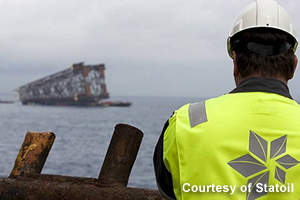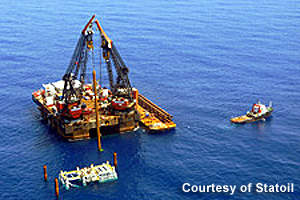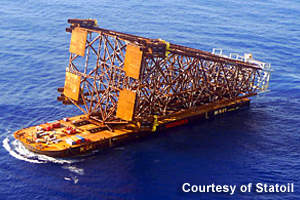The Peregrino field is located in the Campos Basin area, 85km offshore Brazil. The field is owned and operated by Statoil. It lies at a water depth of 100m and is located in the BM-C-7 block.
Statoil and Anadarko originally planned to jointly develop the project but in 2007 Statoil acquired a 100% stake in the field. In May 2010, Statoil sold a 40% stake in the field to Sinochem, and retained the remaining stake and operatorship of the field.
Peregrino’s recoverable reserves are estimated to range from 300 million to 600 million barrels of heavy oil. A seismic data study conducted in 2006 indicated additional upsides in the south-west.
First production from the field was achieved in April 2011 and is expected to continue until 2040.
In April 2011, Statoil made new oil find near the field. The discovery was made by an exploration well drilled into the Peregrino south structure. The well encountered a 130m oil column. Drilling activities are ongoing to explore the reserve potential of the Peregrino area.
Peregrino field development
Statoil submitted a field development plan to the regulatory agency Agencia Nacional do Petroleo in March 2007. It was approved in the same year.
Development will take place in three phases, involving 60 wells. Phase I includes 37 wells, out of which 30 will be production wells and the remaining injection wells.
During the first phase, two drilling and wellhead platforms will be tied back to the floating production storage and offloading (FPSO) unit via flowlines and power umbilicals.
Peregrino A and B platforms
In March 2010, installation of the two platforms was completed by Hermod, a heavy lift vessel. A pair of jacket substructures for the platforms was installed in 2009.
The platforms comprise an eight-legged jacket structure and foundation piles. In addition, well slot conductors, deck structure, equipment and systems, and well decks with cranes, are also included.
Peregrino FPSO
Peregrino’s FPSO was developed by Maersk FPSOs in Singapore. South Atlantic Holding and Maersk FPSOs carried out a FEED study for the FPSO in 2007. Maersk awarded McDermott International the engineering, procurement and construction contract for the topside modules of the FPSO in March 2008. Keppel carried out the conversion of the FPSO.
The 6,500t unit has a production capacity of 100,000bopd and 7.5mmcf per day. The FPSO will operate for 15 years.
The FPSO’s mooring systems were installed in early 2010 via the offshore construction vessel Boa Deep C.
BW Offshore provided a submerged turret production system for the FPSO. An internal turret and mooring was designed, fabricated and delivered by APL technology, a division of BW Offshore. The STP buoy was moored with ten mooring lines. It has 15 risers and umbilical slots.
The contract for mooring system installation was awarded to Aker Solutions in July 2009.
Contracts for Peregrino
Subsea 7 was awarded the engineering, procurement, manufacture and installation contract for the flexible risers at the Peregrino field in May 2007. The scope of work also included the supply and installation of six thermally insulated pipelines and umbilicals.
A $30m contract for the manufacture and installation of surface wellheads and surface production trees was awarded to FMC Technologies in June 2009.
Siem Consub has been chosen to charter a platform support vessel to provide maritime support.
In September 2009, Wood Group was awarded a contract to provide maintenance and support services for the field’s platforms. The $60m contract is for a period of five years.





